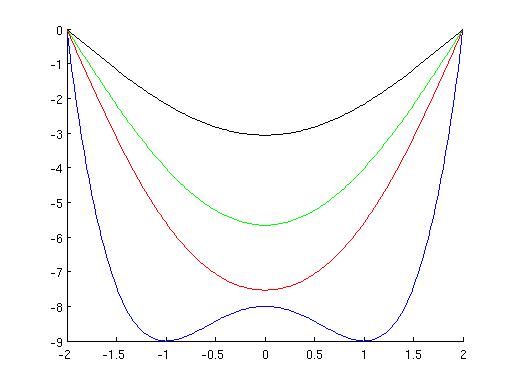
function t5q3(h,k) % set up the grid T = 2 ; Xmin = -2 ; Xmax = 2 ; N = (Xmax-Xmin)/h ; % assume this is an integer M = T/k ; % assume this is an integer x = Xmin + (0:N)*h ; % t = (0:M)*k ; % prepare matrix to hold the solution u = zeros(M+1,N+1); % no need to impose boundary conditions as they are zero u(1,:) = x.^4 - 2*x.^2 - 8 ; % Euler method to evolve for j=1:M u(j+1,2:N) = u(j,2:N) + k/h^2*( u(j,3:(N+1)) - 2*u(j,2:N) + u(j,1:(N-1)) ); end % plot the solution at times 0, 0.5, 1, 2 % color blue,red,green and black figure(1) hold on plot(x,u(1,:),'b'); plot(x,u(M/4+1,:),'r'); plot(x,u(M/2+1,:),'g'); plot(x,u(M+1,:),'k');This works for some choices of h and k and not for others. When it does work nicely I get a plot like this:

For k=1/500 it only works for h=1/10, and not for h=1/20, h=1/40.
For k=1/1000 it works for h=1/10 and h=1/20, and not for h=1/40.
Also for k=1/2000 it works for h=1/10 and h=1/20, and not for h=1/40.
For k=1/4000 it works for h=1/10, h=1/20, and h=1/40.
This is a result of the STABILITY CONDITION k<h^2/2. For example for h=1/40, this condition says k<1/3200. You can check it does work for k=1/3300 but not for k=1/3100. This is the answer for question (a).
For question (b) - the error of the Euler method is supposed to behave as O(k) + O(h^2). Suppose we change the above program to return the approximate value of u(0,1), but changing the first line to
function v=t5q3(h,k)
and adding a line at the end
v=u(M/2+1,N/2+1);
Here are results for h=1/10, and k=1/500,1/1000,1/2000,1/4000:
-5.66050 -5.66140 -5.66185 -5.66207
Using very small k (and h=1/10) gives a value of -5.66229. The above values deviate from this by
0.00179 0.00089 0.00044 0.00022
We see that WHEN WE HALVE k WE HALVE THE CONTRIBUTION TO THE ERROR - confirming that the error dependence on k is O(k).
Here, on the other hand are results for k=1/4000, and h=1/10,1/20,1/40:
-5.66207 -5.66096 -5.66068
We cannot reduce h more without violating the stability condition. But supposing that the value for very small h is -5.66059 (I won't explain how I got this) the errors are
0.00148 0.00037 0.00009
We see that WHEN WE HALVE h WE QUARTER THE CONTRIBUTION TO THE ERROR - confirming that the error dependence on h is O(h^2).
For question (c). Looking at the plot above we see that the function starts out with 2 minima and 1 maximum and then "relaxes" to zero, becoming a "unimodular function", with just a single minimum at zero. How can we find the minimum value of t for which the function is unimodular? Add the following lines in the j loop:
if ( u(j+1,N/2+1)-u(j+1,N/2) ) * ( u(j,N/2+1)-u(j,N/2) ) < 0 v=(j+1)*k; end
(and comment out the previous definition of v). This prints the new time (j+1)k if there is a change in the sign of the slope at x=0.
Running this with k=1/4000,h=1/40 gives the time unimodality is reached as 0.169. Running with k=/20000,h=1/100 gives 0.16885. The accuracy of these answers can be approved, but this is not for here.